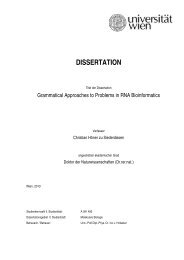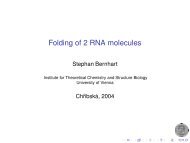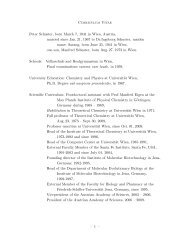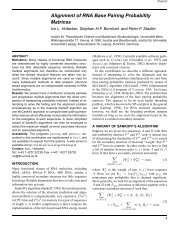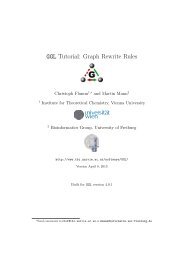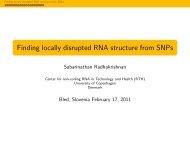A Toy Model of Chemical Reaction Networks - TBI - Universität Wien
A Toy Model of Chemical Reaction Networks - TBI - Universität Wien
A Toy Model of Chemical Reaction Networks - TBI - Universität Wien
You also want an ePaper? Increase the reach of your titles
YUMPU automatically turns print PDFs into web optimized ePapers that Google loves.
Chapter 6<br />
Computational results<br />
When the three components molecules, reactions, and network simulation<br />
are put together, it is possible to build a CRN performing molecular property<br />
prediction and model reduction on the fly, given only a list <strong>of</strong> initial<br />
SMILES. For the following CRNs, regioselectivity was simulated using the<br />
simple equations described at the end <strong>of</strong> section 3.6.<br />
6.1 Repetitive Diels-Alder reactions<br />
The Diels-Alder reaction [25] has been extensively studied thanks to its importance<br />
in natural products synthesis and because it is easily tractable by<br />
simple semi-empirical methods. It is the typical test reaction for a semiempirical<br />
quantum calculation methods such as ours, and furthermore for<br />
the numerous approaches <strong>of</strong> reaction description [110]. It involves the reaction<br />
between two linear π-systems <strong>of</strong> length 2 and 4, called dienophiles<br />
and dienes, and is thus called a [2+4]-cycloaddition. The product is again a<br />
dienophile and may react again in a Diels-Alder reaction, then termed repetitive.<br />
Indeed, the reaction is used for the synthesis <strong>of</strong> polymers [80]. The<br />
CRN in fig. 6.1 is obtained by repetitive Diels-Alder reactions <strong>of</strong> a simple<br />
initial mixture <strong>of</strong> dienes and dienophiles.<br />
The rewrite rule is a bimolecular variant <strong>of</strong> the one described in fig. 4.2<br />
(see appendix B). The simple constraints derived from FMO lead to a reaction<br />
respecting the Woodward-H<strong>of</strong>fmann rules [126]. Depending on which<br />
choice makes |∆E FMO | smaller, the HOMO <strong>of</strong> the diene or dienophile reacts<br />
with the LUMO <strong>of</strong> the complementary species. The orientation <strong>of</strong> the reactants<br />
to each other is determined by the FMO coefficients. <strong>Model</strong> reduction<br />
consisted in producing only one <strong>of</strong> regioisomers instead <strong>of</strong> both. A further<br />
reduction was introduced by an enthalpy threshold <strong>of</strong> 20 eV.<br />
49







